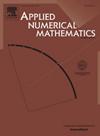基于随机微积分的重叠域分解显式子结构方法
IF 2.2
2区 数学
Q1 MATHEMATICS, APPLIED
引用次数: 0
摘要
在最近的一篇论文[7]中,提出了一种椭圆方程的混合超级计算算法。其思想是,界面节点解求解一个线性系统,其系数是限制在大约子域大小的斑块内的随机微分方程的泛函的期望。与标准的子结构技术(如骨架的Schur补方法)相比,混合方法产生显式和稀疏的萎缩矩阵,因此适合再次进行子结构。最终目标是通过利用随机微积分的并行化潜力,推动强大的可扩展性超越目前的技术水平。在这里,我们提出了对该框架的重大改进,基于将域嵌入重叠圆的覆盖(二维)的洞察力。这允许沿界面(现在是周长)进行有效的傅立叶插值,并且至关重要的是,用于评估大多数界面系统条目作为圆上小边值问题的解决方案。这是非常有效的(因为它们可以并行解决,并通过伪谱方法),没有蒙特卡罗误差。随机数值只需要在相对较少的圆相交的领域边界。总而言之,新公式在保留PDDSparse所有优点的同时,明显更快、更简单、更准确。数值实验是为了说明。本文章由计算机程序翻译,如有差异,请以英文原文为准。
An explicit substructuring method for overlapping domain decomposition based on stochastic calculus
In a recent paper [7], a hybrid supercomputing algorithm for elliptic equations has been proposed. The idea is that the interfacial nodal solutions solve a linear system, whose coefficients are expectations of functionals of stochastic differential equations confined within patches of about subdomain size. Compared to standard substructuring techniques, such as the Schur complement method for the skeleton, the hybrid approach produces an explicit and sparse shrunken matrix—hence suitable for substructuring again. The ultimate goal is to push strong scalability beyond the state of the art by leveraging the potential for parallelisation of stochastic calculus. Here, we present a major revamping of that framework, based on the insight of embedding the domain in a cover of overlapping circles (in two dimensions). This allows for efficient Fourier interpolation along the interfaces (now circumferences) and—crucially—for the evaluation of most of the interfacial system entries as the solution of small boundary value problems on a circle. This is both extremely efficient (as they can be solved in parallel and by the pseudospectral method) and free of Monte Carlo error. Stochastic numerics are only needed on the relatively few circles intersecting the domain boundary. In sum, the new formulation is significantly faster, simpler, and more accurate while retaining all of the advantageous properties of PDDSparse. Numerical experiments are included for the purpose of illustration.
求助全文
通过发布文献求助,成功后即可免费获取论文全文。
去求助
来源期刊

Applied Numerical Mathematics
数学-应用数学
CiteScore
5.60
自引率
7.10%
发文量
225
审稿时长
7.2 months
期刊介绍:
The purpose of the journal is to provide a forum for the publication of high quality research and tutorial papers in computational mathematics. In addition to the traditional issues and problems in numerical analysis, the journal also publishes papers describing relevant applications in such fields as physics, fluid dynamics, engineering and other branches of applied science with a computational mathematics component. The journal strives to be flexible in the type of papers it publishes and their format. Equally desirable are:
(i) Full papers, which should be complete and relatively self-contained original contributions with an introduction that can be understood by the broad computational mathematics community. Both rigorous and heuristic styles are acceptable. Of particular interest are papers about new areas of research, in which other than strictly mathematical arguments may be important in establishing a basis for further developments.
(ii) Tutorial review papers, covering some of the important issues in Numerical Mathematics, Scientific Computing and their Applications. The journal will occasionally publish contributions which are larger than the usual format for regular papers.
(iii) Short notes, which present specific new results and techniques in a brief communication.
 求助内容:
求助内容: 应助结果提醒方式:
应助结果提醒方式:


